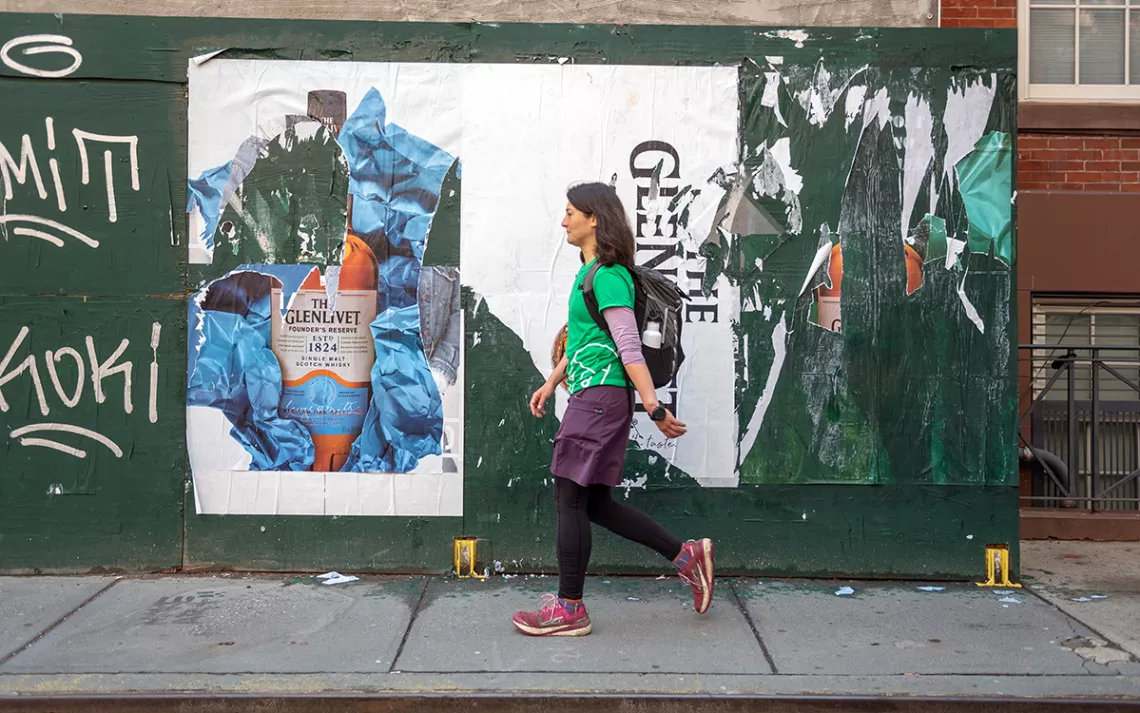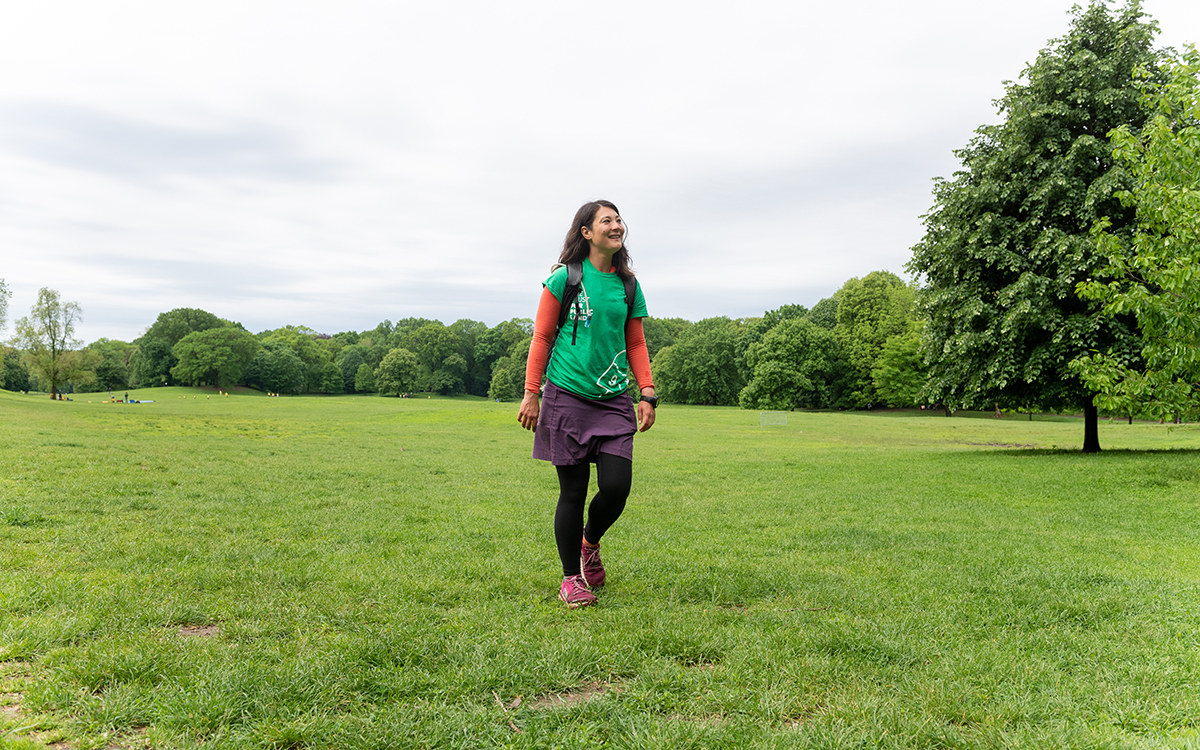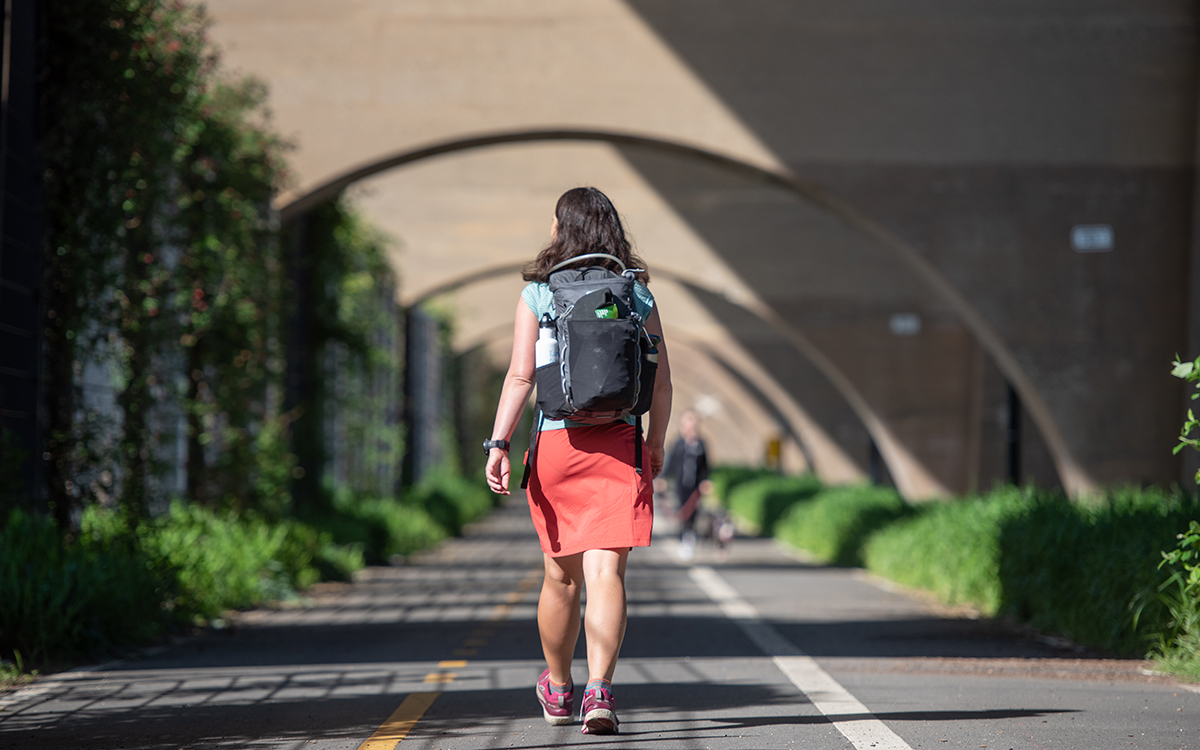A Stroll Across Town With the Pioneer of Urban Thru-Hiking
Inside Liz Thomas’s nine-day NYC trek

Photos by Timothy Schenck, courtesy of the Trust for Public Land
A walk across town does not mean the same thing to Liz Thomas as it does to the rest of us. A petite 34-year-old who goes by her trail name, Snorkel, Thomas has 15,000 miles behind her, including those of the Pacific Crest Trail, the Continental Divide Trail, and the Appalachian Trail, on which she set a speed record.
On a Friday amid morning rain showers in May 2019, during our most recent “normal” spring, she set off from a cafe in Flatbush toward Boerum Hill, by way of Prospect Park and a school in Crown Heights—a 22-mile stroll to cap off a nine-day, 225-mile urban thru-hike of New York City. Snorkel is the pioneer of urban thru-hikes—multiday pedestrian journeys that feature Airbnbs rather than tents and culinary delicacies instead of granola bars. Her hikes always adhere to a theme (public stairways, water, breweries, ice cream), and in New York, she’d been linking up 100 small, bright schoolyard playgrounds built by the Trust for Public Land, because she’s a believer in the value of playing outside and a proponent of hiking what you got.
Snorkel, who’d spent the previous night drinking wine with former classmates from Yale’s School of Forestry, finished her plate of eggs and potatoes, then polished off the eggs and lox of her boyfriend, whose trail name is Mr. Gorbachev, or, more simply, Mr. G. Exhausted from a redeye, Mr. G would not be accompanying Snorkel across Brooklyn. So, after a quick hug, she ventured out into the rain.
Joining Snorkel was one among her 7,000 Instagram followers, a fellow thru-hiker (AT southbound ’16, PCT northbound ’17) who wore minimalist sandals and went by Woodchuck. Daily, Woodchuck walks eight and a half miles (each way) from Flatbush to her office in midtown Manhattan—and couldn’t resist a companion.
Like most people, Snorkel used to think that nature was something distant. In Los Angeles (where she lives and undertook her first urban thru-hike on a dare), she had an epiphany: Walking through the city provided just as much exploration and exercise—not to mention views—as hiking in Yosemite. Besides, there were no bears, permits, or mandatory pieces of high-tech gear, and not only could you stay in touch and wear clean clothes, you didn’t have to poop in the woods. Discomforts be gone!
Using Google Maps on her phone, Snorkel navigated to PS217 and then IS62. On account of the rain, both playgrounds were empty, but she snapped selfies in the parks nonetheless, eager to capture the “deasphalting” that TPL has been performing in New York since she was a fourth grader. Deasphalting (v): converting anemic lots—often cracked, potholed, and puddled, lacking shade or benches or water fountains, featuring little more than crappy basketball courts or handball walls—into vibrant, multipurpose playgrounds, with turf fields and running tracks and gardens and play equipment and a dozen other recreational amenities.
Across all five boroughs, the Trust for Public Land had at the time built 202 such playgrounds, totaling 160 deasphalted acres. Actually, kids built them, or at least designed them, via a surprisingly democratic process that takes a year and a half from initial scheming to ribbon-cutting. Across the city, nearly 7,000 students, from third through 10th grade, have learned how to measure space, slopes, and shade; how to read plans; make scale drawings; consider placement and orientation of features; negotiate with constituents, and meet budgets—basically, how to be landscape architects. Turns out that kids—even troublemakers—make great designers, because they know how to have fun. Who needs Robert Moses?
To Snorkel, the program registered as the kind of progressive participatory conservation—bottom up, instead of top down—that she’d championed in grad school. Somehow, though she considers herself a land conservation nerd, she didn’t learn about the program until last fall, at a conference. Within a minute of meeting TPL’s New York State director, Carter Strickland, she proposed her hike. On the streets of Brooklyn, Snorkel put it this way: “I wanted to save a mountain—which I still want to do–but a mountain is less important than this.” Accessible parks—outdoor spaces within a 10-minute walk of home—resonate more. The only concession she made was making do with visiting half the city’s playgrounds (hitting each would have taken a month).
At the southern corner of Prospect Park, Strickland was waiting for Snorkel with Susan Sharer, of the Prospect Park Alliance. Sharer, in knee-high rubber boots, summarized the significance of Prospect Park as a major spot for migratory birds—and bird watchers. “You think it’s paparazzi, but it’s really birders,” she said. “If you Google ‘painted bunting prospect park,’ there’s so much press. It’s crazy.” Sharer also mentioned a survey in which 90-odd percent of residents said they felt like they belonged in the park—which impressed Snorkel.
Walking resumed, at a ruthlessly consistent three miles per hour, and Strickland asked Snorkel if she’d seen the Queensway—which he called “the people’s High Line”—during her journey. “It was so cool,” Snorkel said. “It’s an asset that’s just sitting there,” Strickland said, more somberly. “It’s been abandoned for 60 years. It’s got 60-year-old trees! It has so much potential. We gotta wait for the next mayor. “He”—de Blasio —“is not that into parks.”
The rain stopped, so Snorkel removed her magenta shell, revealing a green TPL shirt—which, with but one day’s worth of sweat on it, she described as “pretty fresh.” (Against her instincts, Snorkel was allowing herself some urban luxuries: In her small pack she carried four pairs of socks, as well as a hairbrush and a backup phone.) The shirt made Strickland proud. Snorkel's pocketed skirt, however, made by Purple Rain, confused him. “Is it a skort or a skirt?”
Woodchuck steered them to a trail veering northeast and said, “This is where I go to walk to work.”
“Not a bad commute,” Snorkel said. This got Snorkel thinking of her hiking buddies. “I thought Plain Slice and Little Engine would come out, but I guess they had work.” The sun emerged, and the air got steamy. A peacock at the zoo screeched like a terrible alarm. Snorkel kept her eyes up, admiring huge tulip poplars.

All the while, she was trying not to violate her no-backtracking rule too much. But Calvert & Vaux underpasses were hard to pass by. She’d already violated her no-bushwhacking rule when she got “cliffed-out” heading to the High Bridge, and nearly fell off the cliff when she got locked inside the Union Field Cemetery. “I’m not gonna walk through cemeteries ever again even if Google tells me to.” Only one rule remained unbroken: No peeing at Starbucks. Her beef was not with Starbucks so much as New York’s mayors (particularly Giuliani), who, not considering bathrooms a public necessity, have suggested for years that New Yorkers make do with the stalls of a private corporation. To Snorkel the notion was not only impractical—many neighborhoods don’t have a Starbucks—but reprehensible. A city that values pedestrianism needs to invest in pedestrian infrastructure. To her, the true measure of a world-class city is not the grandness of its skyscrapers but the fraction of its population that has access to a park with clean, stocked bathrooms.
“I obviously care about regional, landscape-level conservation, which has major ecological benefits,” she said, “but the people served by that is small.” On a path beside the Eastern Parkway, she added, “What I like about TPL is they’re meeting people where they are—bringing parks to people.”
Just before 11 A.M., Snorkel arrived at MS354, greeted by clapping and the school band. She checked out the garden (“blueberries!”) and still-immaculate playground, met the principal, and admired a before/after poster stuck to the school wall. “This is awesome!” Meanwhile, class by class, uniformed kids filed onto a brand-new field, to celebrate the opening of their new playground—which used to be a parking lot.
From a tiny lectern on a kid-size "stage" between playground equipment and a basketball court, speeches emanated. The regional director of New York State Parks thanked the kids for designing the playground and thanked the principal for making the project happen. “We needed more parks,” she said, “for big people, little people, every people.” State assemblyman Tremaine Wright said he was proud that rather than treating sickness, he was addressing wellness, and told two hundred children in a brand-new playground, “I hope that you use it every single day. I hope that you wear yourselves out in it.”
Together, the kids and the pols cut a green ribbon—and before any teachers could wrangle the students back to classrooms, playing commenced. A sixth grader announced that she was jumpin’ up and down for no reason. Eighth graders tried tagging the rim of the new basketball hoop. Kids scooted through a jungle gym, and others did pushups on the field. Two small kids started playing tag, and four even smaller kids scampered up a slide, screaming and laughing. Snorkel smiled at it all.

According to TPL’s analysis, 99+ percent of New Yorkers live within a 10-minute walk of a park. But if you subtract the school playgrounds (which are open to the public), that figure falls 4 percent, which amounts to 400,000 people. And if you subtract old parks (the average park is 73 years old) and cruddy parks, the figure falls even more. Which makes parks in central Brooklyn and southern Queens—where there’s already a scarcity of parks—that much more vital.
But the best statistic Snorkel heard was anecdotal, passed on from school principals. According to them, post-playground installation, fights decline, as do late arrivals, because kids want to arrive early at school so that they can play. This, in turn, makes teachers happier—which presumably translates to better teaching. Thus: Build a playground, improve education. “It seems like a miracle,” Thomas said, “but it makes sense.”
Snorkel’s aim had been to see the city not as a tourist but as an everyday New Yorker. To her, the value of visiting neighborhoods one typically avoids or ignores was self-evident: A healthy city does not discount invisible people. Searching for an analogy, she quoted Benton MacKaye, who imagined a two-thousand-mile trail from Georgia to Maine in 1921, long before regional planning had a name. “Someone asked him, ‘Why walk the Appalachian trail?’ He said, ‘To see what there is to see.’”
By the end of her final day, Snorkel noted that walking the city wasn’t nearly the challenge she expected. New York presented none of the foodless or bathroomless sections she encountered in L.A., and not half as many cliff-outs as Seattle. She walked through many neighborhoods that she wouldn’t mention to her parents, but never walked past dusk, and was never accosted by what she calls “urban grizzlies.” At worst, she got sunburned. She even enjoyed some trail magic when an official from the Appalachian Mountain Club guided her from Randall’s Island into Queens.
Along the way, she met a forager in Manhattan and the city’s oldest taxidermist in Cypress Hill. She saw three deer (on Staten Island) and three woodchucks (in Brooklyn), and a pack of at least one hundred hungry squirrels (beside JFK.) She was awed by Woodlawn Cemetery and a waterfall in Morningside that she deemed “five-star.” Hudson Yards reminded her of Corsican cliffs. The High Line impressed her, even if she preferred not to walk on cement. Glacial erratics reliably produced a smile, as did the John T. Birch stairs, and white trail blazes like those on the AT. She successfully avoided Starbucks.
In visiting 100 playgrounds, she saw a kid learning to ride a bike and another kid playing with, or at least making sense of, a tree branch. She was smitten by murals, and gardens so popular that sign-up lists became necessary. On only 160 acres, she saw climbing structures, yoga circles, gazebos, tennis courts. At PS242, she saw a hair-braiding area, featuring parallel benches, and at CS366, she saw a basketball court painted purplish-pink, to lure girls. All of it she took in at 3mph, in a nine-day span that seemed like a month.
Before the last day of her thru-hike was over, Thomas had her first slices of NYC pizza (at Saraghina) and also weathered the first thunderstorm of her trip, which washed the remaining Staten Island mud from her sneakers. In store was a night of revelry at 61 Local, followed by a couple of free days before returning to L.A. Did she have a plan? “I dunno,” she said. “Mr. G’s here. He might wanna see things. Maybe I’ll get a hot dog.”
 The Magazine of The Sierra Club
The Magazine of The Sierra Club



